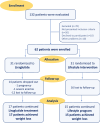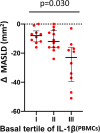Interleukin-1β in circulating mononuclear cells predicts steatotic liver disease improvement after weight loss in subjects with obesity and prediabetes or type 2 diabetes
- PMID: 40514652
- PMCID: PMC12164075
- DOI: 10.1186/s12933-025-02706-8
Interleukin-1β in circulating mononuclear cells predicts steatotic liver disease improvement after weight loss in subjects with obesity and prediabetes or type 2 diabetes
Abstract
Background: Metabolic dysfunction-associated steatotic liver disease (MASLD) is a major cardiovascular risk (CV) factor. Interleukin-1β (IL-1β), a cytokine involved in the pathogenesis of obesity-associated inflammation and type 2 diabetes (T2D), promotes hepatic steatosis. The Canakinumab Anti-inflammatory Thrombosis Outcome (CANTOS) trial showed that the inhibition of the IL-1β pathway was associated with a reduction of CV events in high-risk patients. The present study was designed to determine: (i) whether an equal degree of weight loss by liraglutide or lifestyle changes has a different impact on MASLD extent and IL-1β expression in peripheral blood mononuclear cells from obese subjects with prediabetes or early T2D; (ii) whether baseline IL-1β levels may predict the extent of weight loss and related metabolic changes.
Methods: Thirty-two obese subjects with prediabetes (n = 16) or newly diagnosed T2D (n = 16), were randomized to the glucagon-like peptide receptor agonist (GLP1-RA) liraglutide or lifestyle counselling until achieving a comparable weight loss. Visceral adipose tissue (VAT) and gene expression of IL-1β in peripheral blood mononuclear cells were assessed by magnetic resonance and real time PCR, respectively.
Results: At baseline, IL-1β was positively correlated to body mass index (BMI), fasting plasma glucose, HbA1c, VAT, MASLD extent, platelet count, chemerin and interleukin-1 receptor antagonist (IL1-RA). After achievement of the weight loss target in the two groups, a significant but comparable reduction of IL-1β (p for difference = 0.56) was observed in both arms, in parallel with a comparable improvement in glycaemic control, C reactive protein (CRP), BMI and MASLD. Furthermore, basal IL-1β levels independently predicted the extent of MASLD decrease (p = 0.030); subjects in the highest tertile showed a median decrease of - 8.0 (95% CI - 12.3 to - 4.8) compared with - 23.0 (95% CI - 39.5 to - 16.3) in the lowest tertile.
Conclusion: In patients with obesity with initial impairment of glucose metabolism successful weight loss is associated with a reduction of both IL-1β levels and MASLD degree. Of interest, basal levels of IL-1β predict the extent of MASLD improvement, regardless of the intervention. Our results may set the stage for ad-hoc studies investigating the usefulness of baseline IL-1β a level as a drug-response biomarker.
Keywords: Adipose tissue; Biomarker; Inflammation; Interleukin-1β; Liver disease; MASLD; Obesity; Prediabetes; Type 2 diabetes; Weight-loss.
© 2025. The Author(s).
Conflict of interest statement
Declarations. Ethics approval and consent to participate: The trial was approved by the Italian Ethics Committee of the University of Chieti (Approval n. 10 (protocol 20131) 23.05.2013). Each patient provided written informed consent before participation. Consent for publication: Not applicable. Competing interests: The authors declare no competing interests.
Figures




Similar articles
-
Treatment with orforglipron, an oral glucagon like peptide-1 receptor agonist, is associated with improvements of CV risk biomarkers in participants with type 2 diabetes or obesity without diabetes.Cardiovasc Diabetol. 2025 Jun 6;24(1):240. doi: 10.1186/s12933-025-02781-x. Cardiovasc Diabetol. 2025. PMID: 40481478 Free PMC article. Clinical Trial.
-
Dipeptidyl-peptidase (DPP)-4 inhibitors and glucagon-like peptide (GLP)-1 analogues for prevention or delay of type 2 diabetes mellitus and its associated complications in people at increased risk for the development of type 2 diabetes mellitus.Cochrane Database Syst Rev. 2017 May 10;5(5):CD012204. doi: 10.1002/14651858.CD012204.pub2. Cochrane Database Syst Rev. 2017. PMID: 28489279 Free PMC article.
-
Heterogeneity in response to GLP-1 receptor agonists in type 2 diabetes in real-world clinical practice: insights from the DPV register - an IMI-SOPHIA study.Diabetologia. 2025 Aug;68(8):1666-1673. doi: 10.1007/s00125-025-06448-w. Epub 2025 May 22. Diabetologia. 2025. PMID: 40404820 Free PMC article.
-
Effect of hypoglycemic agents with weight loss effect plus a high protein diet and moderate exercise on diabetes remission in adults with obesity and type 2 diabetes: a randomized controlled trial.BMC Med. 2025 May 7;23(1):270. doi: 10.1186/s12916-025-04072-4. BMC Med. 2025. PMID: 40336033 Free PMC article. Clinical Trial.
-
Indirect comparison of glucagon like peptide-1 receptor agonists regarding cardiovascular safety and mortality in patients with type 2 diabetes mellitus: network meta-analysis.Cardiovasc Diabetol. 2020 Jun 22;19(1):96. doi: 10.1186/s12933-020-01070-z. Cardiovasc Diabetol. 2020. PMID: 32571416 Free PMC article.
References
-
- Lonardo A, et al. Epidemiological modifiers of non-alcoholic fatty liver disease: focus on high-risk groups. Dig Liver Dis. 2015;47:997–1006. - PubMed
-
- Lonardo A, Sookoian S, Pirola CJ, Targher G. Non-alcoholic fatty liver disease and risk of cardiovascular disease. Metabolism. 2016;65:1136–50. - PubMed
-
- Ye Q, Zou B, Yeo YH, et al. Global prevalence, incidence, and outcomes of non-obese or lean non-alcoholic fatty liver disease: a systematic review and meta-analysis. Lancet Gastroenterol Hepatol. 2020;5:739–7525. - PubMed
Publication types
MeSH terms
Substances
Grants and funding
LinkOut - more resources
Full Text Sources
Medical
Research Materials
Miscellaneous

